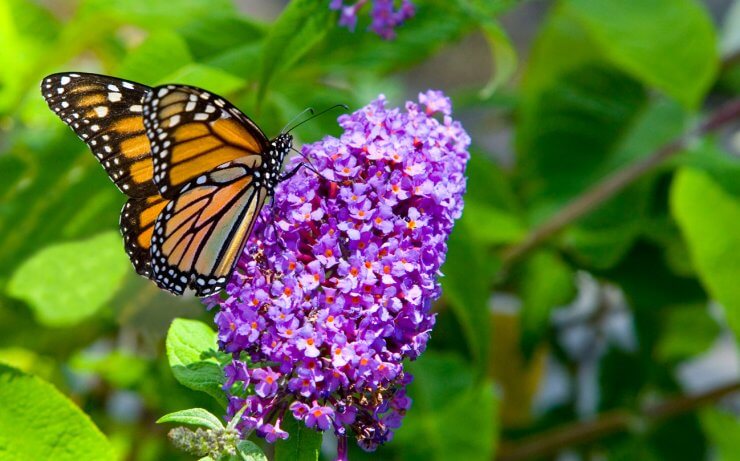
Butterfly gardens are taking flight across America, bringing vibrant colors and delicate wings to backyards everywhere. Gardeners are discovering that creating these flutter-friendly havens can benefit their food gardens in unexpected ways. By choosing the right plants for butterfly gardens, you can create a thriving ecosystem that supports both beautiful butterflies and productive vegetable patches.
The Top Plants to Attract Butterflies (and Their Pollinator Pals!)
If you want to roll out the red carpet for butterflies, you’ll need the right mix of nectar-rich flowers and plants for caterpillars to munch on. Let’s explore some of the most effective plants for butterfly gardens and the specific pollinators they attract.

Discover 10 top tips for growing, harvesting, and enjoying fruits, vegetables, herbs and more from your home garden—when you access the FREEBIE How to Grow a Vegetable Garden, right now!
1. Milkweed (Asclepias spp.)
Butterflies: Monarchs
Pollinators: Bees, honeybees, and hummingbirds
Milkweed is the reigning champion of butterfly gardens, especially if you want to attract the ever-popular monarch butterfly. Monarchs lay their eggs on milkweed, and it’s the only plant their caterpillars eat. Not only does milkweed provide essential nourishment for the next generation of monarchs, but it also produces nectar that draws bees and hummingbirds. It’s like the VIP section of your butterfly garden!

2. Butterfly Bush (Buddleia spp.)
Butterflies: Swallowtails, Painted Ladies, Red Admirals
Pollinators: Bees, wasps, and even hummingbird moths
The butterfly bush is like a magnet for swallowtails and other butterfly species, offering abundant nectar. Its large, fragrant blooms also lure bees and wasps, making it a pollinator favorite. But don’t be surprised if a hummingbird moth sneaks in for a sip, too—they love this plant just as much as the butterflies!

3. Coneflowers (Echinacea spp.)
Butterflies: Fritillaries, Painted Ladies
Pollinators: Bees, bumblebees, and hoverflies
Echinacea, or coneflower, is a double-duty plant in the butterfly garden. The bright blooms provide nectar for butterflies like fritillaries and painted ladies, while the plant’s sturdy structure supports pollinators like bees and hoverflies. It’s also a perennial, so once you plant it, your pollinator pals will keep coming back year after year!

4. Lantana (Lantana camara)
Butterflies: Monarchs, Skippers, and Sulphurs
Pollinators: Bees, hummingbirds
If you want a colorful, low-maintenance option, lantana is the way to go. Its clusters of bright flowers are irresistible to a variety of butterflies and pollinators. Monarchs, skippers, and sulphurs love to feast here, while bees and hummingbirds enjoy sipping from the multi-colored blooms.

5. Zinnias (Zinnia elegans)
Butterflies: Painted Ladies, Monarchs, Swallowtails
Pollinators: Bees, hoverflies
Zinnias are like candy for butterflies. They come in all sorts of bright, cheerful colors and attract butterflies like monarchs, painted ladies, and swallowtails. Plus, they’re a bee favorite. Zinnias are annuals, which means you can easily experiment with different colors and styles each year to see which butterflies stop by!
Pollinators and Food Gardens: A Match Made in Garden Heaven
So, you’ve planted your butterfly garden, and it’s full of fluttering beauties. But what’s the bonus beyond the colorful show? Pollinators! By attracting butterflies, bees, and other pollinators, your garden will also benefit your food crops. These garden guests are nature’s best pollinators, helping to fertilize fruits, vegetables, and herbs. With their help, your tomatoes will be juicier, your cucumbers crisper, and your squash harvest more abundant.
By incorporating these plants for butterfly gardens into your landscape, you’re creating a mutually beneficial environment for both ornamental and edible plants. The best part? Pollinator-friendly plants like coneflowers and zinnias pull double duty by enhancing the beauty of your yard while contributing to the productivity of your veggie patch. It’s like having a natural garden workforce—one that happens to be beautiful and hardworking!
Butterfly Gardening: Fun for Families, Food for Thought
Butterfly gardening is also a fantastic way to get the whole family involved in nature. Kids love watching the transformation from caterpillar to butterfly, and it’s a gentle reminder of the important role pollinators play in the ecosystem. Observing the interaction between butterflies and the plants in butterfly gardens can be an educational experience for the whole family. Plus, there’s something wonderfully calming about sipping a cool lemonade while butterflies flit about, knowing that your garden is contributing to a healthier environment.
Whether you’re looking to increase your food production, boost your flower garden, or simply enjoy the wonder of watching butterflies in flight, creating a butterfly garden is an easy and rewarding way to enhance your backyard. And hey, the bees and hummingbirds will thank you, too!
Plant some zinnias, add some milkweed, and let the fluttering begin! You’ll soon be reaping the rewards in your food garden—and enjoying the beauty all season long.
Please download our free butterfly garden planting chart, and be sure to check out our complete guidebook on Butterfly Gardening in America.
Have you started planning your butterfly garden? I’d love to hear about your experiences with plants for butterfly gardens. Share your thoughts, successes, or questions in the comments below!





Your second suggestion for a plant to attract butterflies is invasive. Look up butterfly plant and you will see several websites that urge you not to plant it, or to replace it if it is already in your garden.
I have never had a problem with my butterfly bush spreading ,but Lantana and Conflowers spreads because of the way the seeds fall.